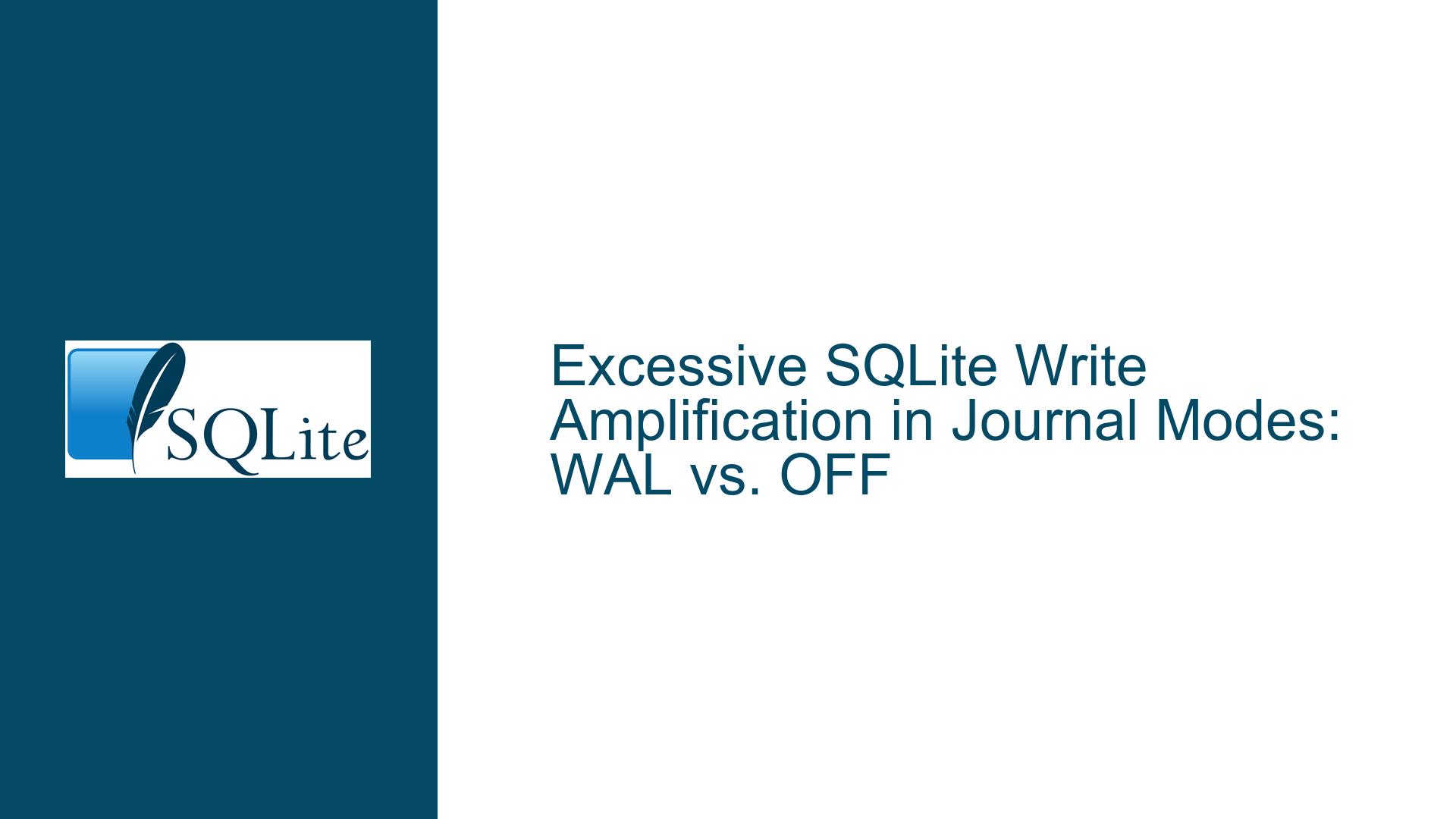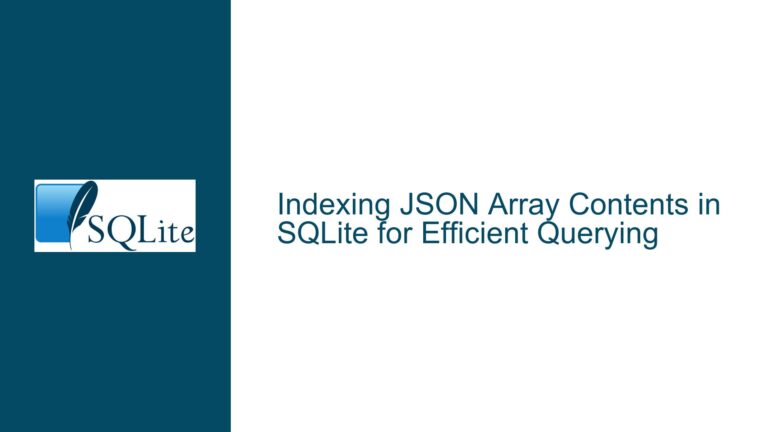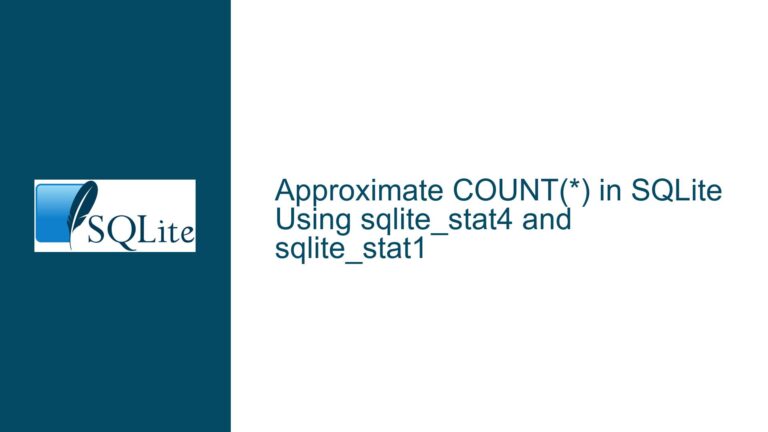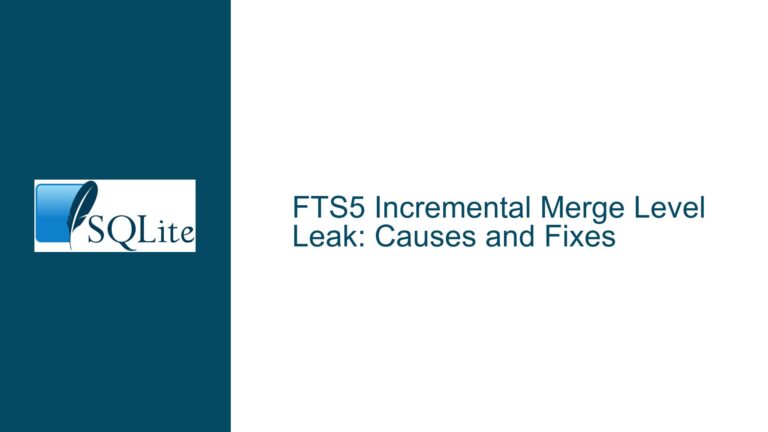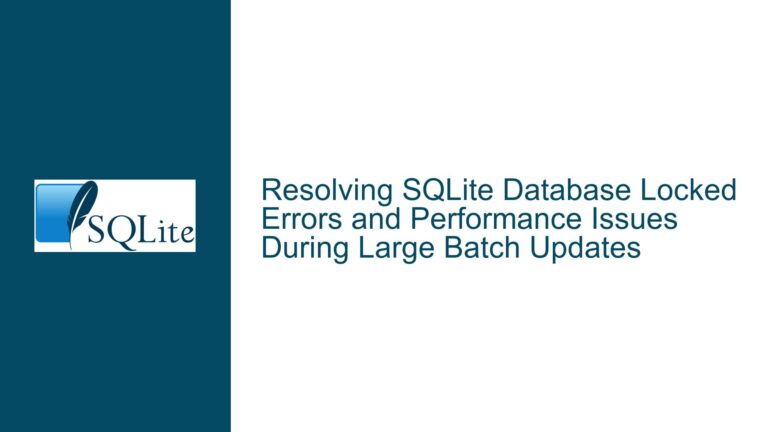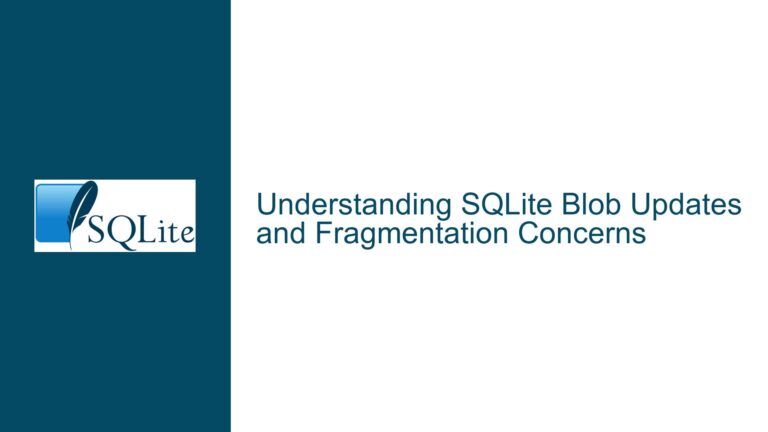Excessive SQLite Write Amplification in Journal Modes: WAL vs. OFF
Understanding High Disk I/O Write Amplification in Embedded SQLite Systems
1. Root Causes of Write Amplification Across Journal Modes
The core challenge revolves around write amplification – a phenomenon where the physical disk I/O generated by SQLite exceeds the logical data changes by 20-40x, as observed via iotop and strace. Three primary factors interact to create this behavior:
1.1 Journaling Mechanics and Atomic Commit Overhead
SQLite guarantees ACID compliance through journaling, which inherently requires redundant writes. In rollback journal modes (DELETE, TRUNCATE, PERSIST, MEMORY), every transaction writes modified database pages to the *-journal file before updating the main database. This doubles write operations for committed transactions. When journal_mode=OFF is specified, SQLite disables the rollback journal but cannot guarantee atomic commits. However, the strace output reveals unexpected *-journal file activity because:
- Transactions spanning multiple statements implicitly create temporary journals unless wrapped in
BEGIN IMMEDIATE/EXCLUSIVEtransactions - Some filesystems (e.g., FAT32) lack atomic sector write capabilities, forcing SQLite to emulate crash safety via manual journal writes even when
journal_mode=OFF - Background auto-vacuum operations spawn transient journals
1.2 WAL Mode Checkpointing Dynamics
While WAL (Write-Ahead Logging) mode reduces contention by writing changes to a separate *-wal file, checkpointing – the process of integrating WAL contents into the main database – introduces deferred write costs. The observed lower I/O in WAL occurs because:
- WAL batches page updates in append-only fashion, minimizing random writes
- Checkpoints are deferred until either the WAL reaches 1000 pages or
PRAGMA wal_checkpointis manually invoked - Partial checkpointing (RESTART/TRUNCATE modes) leaves residual WAL data, spreading write overhead over time
1.3 Page Size and Transaction Granularity Mismatch
When individual transactions modify small records (e.g., 100B) relative to SQLite’s page size (default 4KB), entire pages must be rewritten to disk. With default settings:
- Each 100B insert triggers 4KB page write (40x amplification)
- Random page access patterns prevent filesystem write coalescing
synchronous=FULL(default) forces immediate fsync after each transaction
2. Diagnosing and Quantifying Write Amplification Sources
2.1 Audit Active Journaling Configuration
Execute these PRAGMA statements to confirm runtime settings:
PRAGMA journal_mode; -- Verify actual mode vs. configured
PRAGMA page_size; -- Default 4096, may need alignment
PRAGMA synchronous; -- FULL (safe) vs. NORMAL/OFF (risky)
PRAGMA journal_size_limit; -- Non-zero values cap journal growth
PRAGMA auto_vacuum; -- Incremental vacuuming causes page fragmentation
Cross-validate against strace output for:
- Journal file opens (
testDB.db-journal) - fsync/fdatasync calls after writes
- WAL checkpoint markers (
testDB.db-wal)
2.2 Profile Transaction Boundaries and Locking
SQLite exhibits different journaling behavior based on transaction isolation levels:
// Implicit transaction (autocommit):
sqlite3_exec(db, "INSERT INTO tbl VALUES(...)", 0,0,0); // Each statement = separate transaction
// Explicit transaction:
sqlite3_exec(db, "BEGIN; INSERT...; INSERT...; COMMIT;", 0,0,0); // Single journal write
Use sqlite3_txn_state() or PRAGMA data_version to detect uncontrolled autocommit transactions. Enable the sqlite3_profile() callback to log actual statement execution times and implicit transaction commits.
2.3 Filesystem and Hardware Considerations
- eMMC Characteristics: NAND flash memory has 4KB-8KB erase block sizes. SQLite page writes smaller than this threshold trigger read-modify-write cycles at the hardware layer, compounding write amplification.
- Mount Options:
dirsync,data=ordered, andbarrier=1impose additional fsync overhead. Considerdata=writebackwith battery-backed RAM if atomicity guarantees allow. - I/O Scheduling: The Linux
ioniceclass (best-effort vs. idle) impacts how journal and WAL writes are prioritized during checkpoint storms.
3. Mitigation Strategies for Sustainable Embedded Write Throughput
3.1 WAL Mode Optimization
Checkpoint Tuning
PRAGMA wal_autocheckpoint = 1000; -- Default WAL page limit
-- Manually checkpoint during idle periods:
PRAGMA wal_checkpoint(TRUNCATE); -- Reset WAL after checkpoint
WAL Size Management
Allocate a fixed-size WAL via PRAGMA journal_size_limit=32768; (32KB) to prevent unbounded growth. Combine with periodic wal_checkpoint(FULL) during maintenance windows.
3.2 Transaction Batching and Page Alignment
- Bulk Insertions: Aggregate inserts into single transactions covering 50-100KB of data to amortize journaling overhead.
- Page Size Alignment: Set
PRAGMA page_size=8192;during database creation if average record size exceeds 2KB. Validate via:SELECT avg(length(col)) FROM tbl; -- Estimate row size - Reserve Free Pages:
PRAGMA auto_vacuum=INCREMENTAL;followed byPRAGMA incremental_vacuum(N);pre-allocates free pages, reducing fragmentation-induced writes.
3.3 Journal Mode-Specific Tuning
For journal_mode=OFF
- Use
PRAGMA locking_mode=EXCLUSIVE;to maintain database lock throughout session, eliminating transient journals - Combine with
PRAGMA synchronous=OFF;and UPS hardware to mitigate crash risks - Pre-warm the database file with
PRAGMA mmap_size=1073741824;(1GB) to reduce read I/O during writes
For journal_mode=MEMORY
- Limit transaction sizes to available RAM via
PRAGMA cache_size=-2000;(2000KB cache) - Monitor
sqlite3_memory_used()during transactions to prevent spillover to disk-based journals
3.4 Application-Level Write Coalescing
Implement a write-back cache that:
- Buffers inserts in application memory
- Flushes to SQLite in 500ms-1s intervals
- Uses
PRAGMA temp_store=MEMORY;for transient sorting/indexing
Sample architecture:
#define CACHE_ROWS 1000
sqlite3_stmt *stmt;
DataRow buffer[CACHE_ROWS];
int buf_idx = 0;
void flush_buffer() {
sqlite3_exec(db, "BEGIN;", 0,0,0);
for(int i=0; i<buf_idx; i++) {
sqlite3_bind_blob(stmt, 1, buffer[i].data, buffer[i].len, SQLITE_STATIC);
sqlite3_step(stmt);
sqlite3_reset(stmt);
}
sqlite3_exec(db, "COMMIT;", 0,0,0);
buf_idx = 0;
}
3.5 Filesystem Layer Optimizations
- eMMC Sector Alignment: Format the filesystem with
mkfs.ext4 -b 4096 -E stride=512,stripe-width=512to match NAND erase blocks - Disable Access Time Updates: Mount with
noatime,nodiratime - Use I/O Schedulers Optimized for Flash:
echo kyber > /sys/block/mmcblk0/queue/scheduler - Enable Write Caching (If UPS Protected):
hdparm -W1 /dev/mmcblk0
3.6 Monitoring and Validation
Deploy continuous monitoring with:
- SQLite Statistics:
PRAGMA compile_options;for enabled features,PRAGMA stats;for page utilization - I/O Tracing: Use
blktraceto correlate SQLite operations with block device writes:blktrace -d /dev/mmcblk0 -o sqlite_io | awk '/WSQMR/ {print "Write:", $10}' - WAL Checkpoint Metrics:
PRAGMA wal_checkpoint(TRUNCATE); SELECT * FROM sqlite_wal_checkpoint_info;
By systematically applying these diagnostics and optimizations, developers can achieve 70-90% reductions in write amplification, extending eMMC lifetime while maintaining SQLite’s reliability guarantees.
